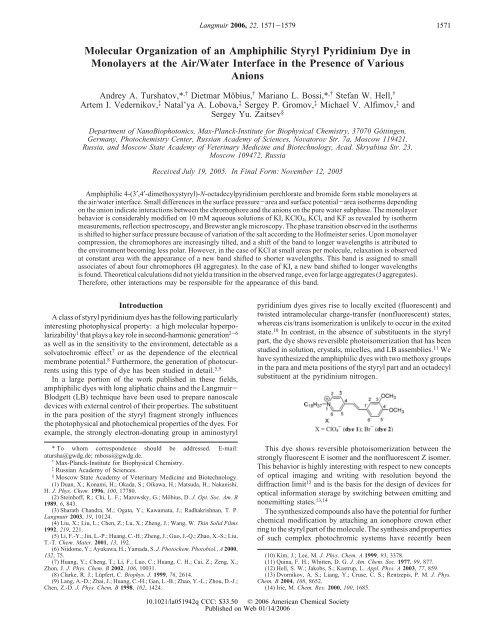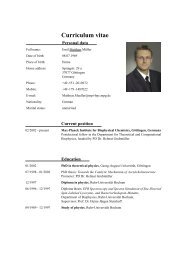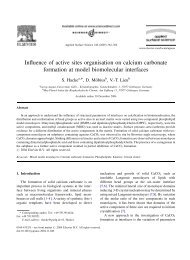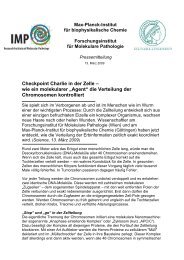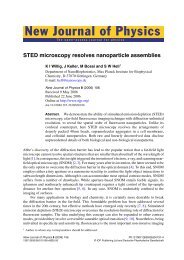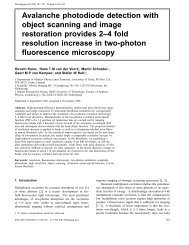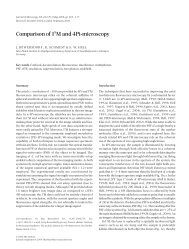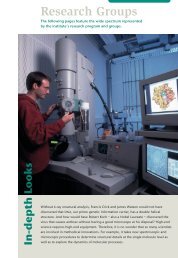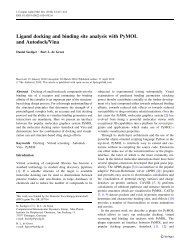Molecular Organization of an Amphiphilic Styryl Pyridinium Dye in ...
Molecular Organization of an Amphiphilic Styryl Pyridinium Dye in ...
Molecular Organization of an Amphiphilic Styryl Pyridinium Dye in ...
You also want an ePaper? Increase the reach of your titles
YUMPU automatically turns print PDFs into web optimized ePapers that Google loves.
<strong>Molecular</strong> <strong>Org<strong>an</strong>ization</strong> <strong>of</strong> <strong>an</strong> <strong>Amphiphilic</strong> <strong>Styryl</strong> <strong>Pyrid<strong>in</strong>ium</strong> <strong>Dye</strong> <strong>in</strong><br />
Monolayers at the Air/Water Interface <strong>in</strong> the Presence <strong>of</strong> Various<br />
Anions<br />
Andrey A. Turshatov,* ,† Dietmar Möbius, † Mari<strong>an</strong>o L. Bossi,* ,† Stef<strong>an</strong> W. Hell, †<br />
Artem I. Vedernikov, ‡ Natal’ya A. Lobova, ‡ Sergey P. Gromov, ‡ Michael V. Alfimov, ‡ <strong>an</strong>d<br />
Sergey Yu. Zaitsev §<br />
Department <strong>of</strong> N<strong>an</strong>oBiophotonics, Max-Pl<strong>an</strong>ck-Institute for Biophysical Chemistry, 37070 Gött<strong>in</strong>gen,<br />
Germ<strong>an</strong>y, Photochemistry Center, Russi<strong>an</strong> Academy <strong>of</strong> Sciences, NoVatoroV Str. 7a, Moscow 119421,<br />
Russia, <strong>an</strong>d Moscow State Academy <strong>of</strong> Veter<strong>in</strong>ary Medic<strong>in</strong>e <strong>an</strong>d Biotechnology, Acad. Skryab<strong>in</strong>a Str. 23,<br />
Moscow 109472, Russia<br />
ReceiVed July 19, 2005. In F<strong>in</strong>al Form: NoVember 12, 2005<br />
<strong>Amphiphilic</strong> 4-(3′,4′-dimethoxystyryl)-N-octadecylpyrid<strong>in</strong>ium perchlorate <strong>an</strong>d bromide form stable monolayers at<br />
the air/water <strong>in</strong>terface. Small differences <strong>in</strong> the surface pressure-area <strong>an</strong>d surface potential-area isotherms depend<strong>in</strong>g<br />
on the <strong>an</strong>ion <strong>in</strong>dicate <strong>in</strong>teractions between the chromophore <strong>an</strong>d the <strong>an</strong>ions on the pure water subphase. The monolayer<br />
behavior is considerably modified on 10 mM aqueous solutions <strong>of</strong> KI, KClO4, KCl, <strong>an</strong>d KF as revealed by isotherm<br />
measurements, reflection spectroscopy, <strong>an</strong>d Brewster <strong>an</strong>gle microscopy. The phase tr<strong>an</strong>sition observed <strong>in</strong> the isotherms<br />
is shifted to higher surface pressure because <strong>of</strong> variation <strong>of</strong> the salt accord<strong>in</strong>g to the H<strong>of</strong>meister series. Upon monolayer<br />
compression, the chromophores are <strong>in</strong>creas<strong>in</strong>gly tilted, <strong>an</strong>d a shift <strong>of</strong> the b<strong>an</strong>d to longer wavelengths is attributed to<br />
the environment becom<strong>in</strong>g less polar. However, <strong>in</strong> the case <strong>of</strong> KCl at small areas per molecule, relaxation is observed<br />
at const<strong>an</strong>t area with the appear<strong>an</strong>ce <strong>of</strong> a new b<strong>an</strong>d shifted to shorter wavelengths. This b<strong>an</strong>d is assigned to small<br />
associates <strong>of</strong> about four chromophores (H aggregates). In the case <strong>of</strong> KI, a new b<strong>an</strong>d shifted to longer wavelengths<br />
is found. Theoretical calculations did not yield a tr<strong>an</strong>sition <strong>in</strong> the observed r<strong>an</strong>ge, even for large aggregates (J aggregates).<br />
Therefore, other <strong>in</strong>teractions may be responsible for the appear<strong>an</strong>ce <strong>of</strong> this b<strong>an</strong>d.<br />
Introduction<br />
A class <strong>of</strong> styryl pyrid<strong>in</strong>ium dyes has the follow<strong>in</strong>g particularly<br />
<strong>in</strong>terest<strong>in</strong>g photophysical property: a high molecular hyperpolarizability1<br />
that plays a key role <strong>in</strong> second-harmonic generation2-6 as well as <strong>in</strong> the sensitivity to the environment, detectable as a<br />
solvatochromic effect7 or as the dependence <strong>of</strong> the electrical<br />
membr<strong>an</strong>e potential. 8 Furthermore, the generation <strong>of</strong> photocurrents<br />
us<strong>in</strong>g this type <strong>of</strong> dye has been studied <strong>in</strong> detail. 5,9<br />
In a large portion <strong>of</strong> the work published <strong>in</strong> these fields,<br />
amphiphilic dyes with long aliphatic cha<strong>in</strong>s <strong>an</strong>d the L<strong>an</strong>gmuir-<br />
Blodgett (LB) technique have been used to prepare n<strong>an</strong>oscale<br />
devices with external control <strong>of</strong> their properties. The substituent<br />
<strong>in</strong> the para position <strong>of</strong> the styryl fragment strongly <strong>in</strong>fluences<br />
the photophysical <strong>an</strong>d photochemical properties <strong>of</strong> the dyes. For<br />
example, the strongly electron-donat<strong>in</strong>g group <strong>in</strong> am<strong>in</strong>ostyryl<br />
* To whom correspondence should be addressed. E-mail:<br />
atursha@gwdg.de; mbossi@gwdg.de.<br />
† Max-Pl<strong>an</strong>ck-Institute for Biophysical Chemistry.<br />
‡ Russi<strong>an</strong> Academy <strong>of</strong> Sciences.<br />
§ Moscow State Academy <strong>of</strong> Veter<strong>in</strong>ary Medic<strong>in</strong>e <strong>an</strong>d Biotechnology.<br />
(1) Du<strong>an</strong>, X.; Konami, H.; Okada, S.; Oikawa, H.; Matsuda, H.; Nak<strong>an</strong>ishi,<br />
H. J. Phys. Chem. 1996, 100, 17780.<br />
(2) Ste<strong>in</strong>h<strong>of</strong>f, R.; Chi, L. F.; Marowsky, G.; Möbius, D. J. Opt. Soc. Am. B<br />
1989, 6, 843.<br />
(3) Sharath Ch<strong>an</strong>dra, M.; Ogata, Y.; Kawamata, J.; Radhakrishn<strong>an</strong>, T. P.<br />
L<strong>an</strong>gmuir 2003, 19, 10124.<br />
(4) Liu, X.; Liu, L.; Chen, Z.; Lu, X.; Zheng, J.; W<strong>an</strong>g, W. Th<strong>in</strong> Solid Films<br />
1992, 219, 221.<br />
(5) Li, F.-Y.; J<strong>in</strong>, L.-P.; Hu<strong>an</strong>g, C.-H.; Zheng, J.; Guo, J.-Q.; Zhao, X.-S.; Liu,<br />
T.-T. Chem. Mater. 2001, 13, 192.<br />
(6) Niidome, Y.; Ayukawa, H.; Yamada, S. J. Photochem. Photobiol., A 2000,<br />
132, 75.<br />
(7) Hu<strong>an</strong>g, Y.; Cheng, T.; Li, F.; Luo, C.; Hu<strong>an</strong>g, C. H.; Cai, Z.; Zeng, X.;<br />
Zhon, J. J. Phys. Chem. B 2002, 106, 10031.<br />
(8) Clarke, R. J.; Lüpfert, C. Biophys. J. 1999, 76, 2614.<br />
(9) L<strong>an</strong>g, A.-D.; Zhai, J.; Hu<strong>an</strong>g, C.-H.; G<strong>an</strong>, L.-B.; Zhao, Y.-L.; Zhou, D.-J.;<br />
Chen, Z.-D. J. Phys. Chem. B 1998, 102, 1424.<br />
L<strong>an</strong>gmuir 2006, 22, 1571-1579<br />
10.1021/la051942q CCC: $33.50 © 2006 Americ<strong>an</strong> Chemical Society<br />
Published on Web 01/14/2006<br />
1571<br />
pyrid<strong>in</strong>ium dyes gives rise to locally excited (fluorescent) <strong>an</strong>d<br />
twisted <strong>in</strong>tramolecular charge-tr<strong>an</strong>sfer (nonfluorescent) states,<br />
whereas cis/tr<strong>an</strong>s isomerization is unlikely to occur <strong>in</strong> the exited<br />
state. 10 In contrast, <strong>in</strong> the absence <strong>of</strong> substituents <strong>in</strong> the styryl<br />
part, the dye shows reversible photoisomerization that has been<br />
studied <strong>in</strong> solution, crystals, micelles, <strong>an</strong>d LB assemblies. 11 We<br />
have synthesized the amphiphilic dyes with two methoxy groups<br />
<strong>in</strong> the para <strong>an</strong>d meta positions <strong>of</strong> the styryl part <strong>an</strong>d <strong>an</strong> octadecyl<br />
substituent at the pyrid<strong>in</strong>ium nitrogen.<br />
This dye shows reversible photoisomerization between the<br />
strongly fluorescent E isomer <strong>an</strong>d the nonfluorescent Z isomer.<br />
This behavior is highly <strong>in</strong>terest<strong>in</strong>g with respect to new concepts<br />
<strong>of</strong> optical imag<strong>in</strong>g <strong>an</strong>d writ<strong>in</strong>g with resolution beyond the<br />
diffraction limit 12 <strong>an</strong>d is the basis for the design <strong>of</strong> devices for<br />
optical <strong>in</strong>formation storage by switch<strong>in</strong>g between emitt<strong>in</strong>g <strong>an</strong>d<br />
nonemitt<strong>in</strong>g states. 13,14<br />
The synthesized compounds also have the potential for further<br />
chemical modification by attach<strong>in</strong>g <strong>an</strong> ionophore crown ether<br />
r<strong>in</strong>g to the styryl part <strong>of</strong> the molecule. The synthesis <strong>an</strong>d properties<br />
<strong>of</strong> such complex photochromic systems have recently been<br />
(10) Kim, J.; Lee, M. J. Phys. Chem. A 1999, 93, 3378.<br />
(11) Qu<strong>in</strong>a, F. H.; Whitten, D. G. J. Am. Chem. Soc. 1977, 99, 877.<br />
(12) Hell, S. W.; Jakobs, S.; Kastrup, L. Appl. Phys. A 2003, 77, 859.<br />
(13) Dvornikov, A. S.; Li<strong>an</strong>g, Y.; Cruse, C. S.; Rentzepis, P. M. J. Phys.<br />
Chem. B 2004, 108, 8652.<br />
(14) Irie, M. Chem. ReV. 2000, 100, 1685.
1572 L<strong>an</strong>gmuir, Vol. 22, No. 4, 2006 TurshatoV et al.<br />
published. 15 From this po<strong>in</strong>t <strong>of</strong> view, the styryl dyes presented<br />
here may be considered to be model compounds for the study<br />
<strong>of</strong> the org<strong>an</strong>ization <strong>in</strong> monolayers <strong>an</strong>d <strong>of</strong> the photochemical<br />
behavior <strong>of</strong> dyes conta<strong>in</strong><strong>in</strong>g the additional ionophore group.<br />
In this article, we discuss stability <strong>an</strong>d association phenomena<br />
<strong>of</strong> the dyes <strong>in</strong> monolayers at the air-water <strong>in</strong>terface <strong>in</strong> the presence<br />
<strong>of</strong> various <strong>an</strong>ions. We <strong>in</strong>vestigated the effect <strong>of</strong> different <strong>an</strong>ions<br />
by measur<strong>in</strong>g surface pressure-area <strong>an</strong>d surface potential-area<br />
isotherms as well as us<strong>in</strong>g reflection spectroscopy <strong>an</strong>d Brewster<br />
<strong>an</strong>gle microscopy (BAM). These methods, <strong>in</strong> particular, reflection<br />
spectroscopy, provide <strong>in</strong>formation on chromophore orientation<br />
<strong>an</strong>d association <strong>in</strong> monolayers. The unattended, very strong<br />
<strong>in</strong>fluence <strong>of</strong> the chemical nature <strong>of</strong> <strong>an</strong>ions on molecular<br />
org<strong>an</strong>ization <strong>an</strong>d spectroscopic properties <strong>of</strong> cationic amphiphiles<br />
has caught our attention because we expect similar effects on<br />
monolayers <strong>of</strong> other cationic dyes. However, this fact is poorly<br />
discussed <strong>in</strong> the literature.<br />
The specific <strong>in</strong>fluence <strong>of</strong> <strong>an</strong>ions on the properties <strong>of</strong> the surface<br />
<strong>of</strong> salt solutions <strong>in</strong> the absence <strong>of</strong> <strong>an</strong> <strong>in</strong>soluble lipid monolayer<br />
is well known <strong>an</strong>d is classified accord<strong>in</strong>g to the H<strong>of</strong>meister series<br />
<strong>of</strong> <strong>an</strong>ions. This series <strong>of</strong> <strong>an</strong>ions was established <strong>in</strong> the 19th century<br />
on the basis <strong>of</strong> studies <strong>of</strong> the solubility <strong>of</strong> prote<strong>in</strong>s <strong>in</strong> electrolyte<br />
solutions. 16 The tr<strong>an</strong>slation to English <strong>of</strong> two orig<strong>in</strong>al articles<br />
from a series <strong>of</strong> H<strong>of</strong>meister’s works is available. 17 The follow<strong>in</strong>g<br />
<strong>in</strong>vestigations showed that the H<strong>of</strong>meister series is applicable<br />
not only to biological phenomena but also to a wide r<strong>an</strong>ge <strong>of</strong><br />
<strong>in</strong>terfacial phenomena <strong>in</strong>clud<strong>in</strong>g the surface properties <strong>of</strong> salt<br />
solutions, 18-20 the colloid stability <strong>of</strong> latex, 21,22 the adsorption<br />
<strong>of</strong> ionic surfact<strong>an</strong>ts at the air/water <strong>in</strong>terface, 23-27 <strong>an</strong>d the<br />
org<strong>an</strong>ization <strong>of</strong> octadecylam<strong>in</strong>e 28 <strong>an</strong>d dimethyl-dioctadecylammonium<br />
salts, 29 calixarenes, 30 <strong>an</strong>d 1,2-dipalmitoyl-phosphatidylchol<strong>in</strong>e<br />
<strong>in</strong> L<strong>an</strong>gmuir monolayers. 31 The H<strong>of</strong>meister series <strong>of</strong><br />
<strong>an</strong>ions may be slightly different, depend<strong>in</strong>g on the studied<br />
phenomenon. In <strong>an</strong>y case, one end <strong>of</strong> the sequence <strong>in</strong>cludes<br />
large, highly polarizable <strong>an</strong>ions such as I - , ClO4 - , <strong>an</strong>d CNS - .<br />
The <strong>in</strong>fluence <strong>of</strong> these <strong>an</strong>ions may be quite specific <strong>in</strong> some<br />
cases. The other end <strong>of</strong> the sequence <strong>in</strong>cludes ions F - ,OH - ,<br />
SO4 2- , <strong>an</strong>d HPO4 2- . Accord<strong>in</strong>g to N<strong>in</strong>ham <strong>an</strong>d Boström, the<br />
differences are related to the strength <strong>of</strong> dispersion <strong>in</strong>teractions<br />
<strong>an</strong>d the ion solvation energy. 32,33 The role <strong>of</strong> dehydration near<br />
the <strong>in</strong>terface was also emphasized by other authors. 34-36 In<br />
(15) Gromov, S. P.; Ushakov, E. N.; Fedorova, O. A.; Bask<strong>in</strong>, I. I.; Buevich,<br />
A. V.; Andryukh<strong>in</strong>a, E. N.; Alfimov, M. V.; Johnels, D.; Edlund, U. G.; Whitesell,<br />
J. K.; Fox, M. A. J. Org. Chem. 2003, 68, 6115.<br />
(16) H<strong>of</strong>meister, F. Arch. Exp. Pathol. Pharmakol. 1888, 24, 247.<br />
(17) Kunz, W.; Henle, J.; N<strong>in</strong>ham, B. W. Curr. Op<strong>in</strong>. Colloid Interface Sci.<br />
2004, 9, 19.<br />
(18) Weissenborn, P. K.; Pugh, R. J. J. Colloid Interface Sci. 1996, 184, 550.<br />
(19) Boström, M.; Kunz, W.; N<strong>in</strong>ham, B. W. L<strong>an</strong>gmuir 2005, 21, 2619.<br />
(20) Mucha, M.; Frigato, T.; Lever<strong>in</strong>g, L. M.; Allen, H. C.; Tobias, D. J. J.<br />
Phys. Chem. B 2005, 109, 7617.<br />
(21) López-León, T.; Jódar-Reyes, A. B.; Ortega-V<strong>in</strong>uesa, J. L.; Bastos-<br />
González, D. J. Colloid Interface Sci. 2005, 284, 139.<br />
(22) López-León, T.; Gea-Jódar, P. M.; Bastos-González, D.; Ortega-V<strong>in</strong>uesa,<br />
J. L. L<strong>an</strong>gmuir 2005, 21, 87.<br />
(23) Knock, M. M.; Ba<strong>in</strong>, C. D. L<strong>an</strong>gmuir 2000, 16, 2857.<br />
(24) Teppner, R.; Haage, K.; W<strong>an</strong>tke, D.; Motschm<strong>an</strong>n, H. J. Phys. Chem. B<br />
2000, 104, 11489.<br />
(25) Koelsch, P.; Motschm<strong>an</strong>n, H. L<strong>an</strong>gmuir 2005, 21, 3436.<br />
(26) Warszynski, P.; Lunkenheimer, G.; Czichocki, G. L<strong>an</strong>gmuir 2002, 18,<br />
2506.<br />
(27) Para, G.; Warszynski, P.; Jarek, E. Colloids Surf., A 2005, 261, 65.<br />
(28) Gurau, M. C.; Lim, S.-M.; Castell<strong>an</strong>a, E. T.; Albertorio, F.; Kataoka, S.;<br />
Cremer, P. S. J. Am. Chem. Soc. 2004, 126, 10522.<br />
(29) Ahuja, R. C.; Caruso, P.-L.; Möbius, D. Th<strong>in</strong> Solid Films 1994, 242, 195.<br />
(30) Lonetti, B.; Lo Nostro, P.; N<strong>in</strong>ham, B. W.; Baglioni, P. L<strong>an</strong>gmuir 2005,<br />
21, 2242.<br />
(31) Aroti, A.; Leontidis, E.; Maltseva, E.; Brezes<strong>in</strong>ski, G. J. Phys. Chem. B<br />
2004, 108, 15238.<br />
(32) Boström, M.; N<strong>in</strong>ham, B. W. L<strong>an</strong>gmuir 2004, 20, 7569.<br />
(33) Boström, M.; N<strong>in</strong>ham, B. W. Biophys. Chem. 2005, 114, 95.<br />
(34) Jungwirth, P.; Tobias, D. J. J. Phys. Chem. B 2002, 106, 6361.<br />
addition, Monte Carlo simulations have shown that ions may<br />
cause a breakdown <strong>of</strong> the hydrogen-bond network <strong>in</strong> the vic<strong>in</strong>ity<br />
<strong>of</strong> the ions, 37 but later experimental results 38,39 have shown that<br />
this effect is not very strong.<br />
Materials <strong>an</strong>d Methods<br />
The synthesis <strong>of</strong> the dyes has been previously described. 40 After<br />
m<strong>in</strong>or alterations <strong>in</strong> the precipitation procedure, we obta<strong>in</strong>ed the dye<br />
with two different <strong>an</strong>ions: ClO4 - (dye 1) <strong>an</strong>d Br- (dye 2). Chlor<strong>of</strong>orm<br />
(Baker, 99.8% purity) was used as the solvent for prepar<strong>in</strong>g<br />
monolayers <strong>of</strong> the dyes. All other solvents were purchased from<br />
Merck with a purity <strong>of</strong> 99.5% <strong>an</strong>d were used without additional<br />
purification. All salts were purchased from Merck with a purity <strong>of</strong><br />
99.5% with the exception <strong>of</strong> potassium perchlorate (99+% purity),<br />
which was purchased from Sigma-Aldrich.<br />
The surface pressure (π)-area (A) <strong>an</strong>d surface potential (∆V)area<br />
(A) isotherms <strong>of</strong> dye monolayers were recorded on a rect<strong>an</strong>gular<br />
trough made <strong>of</strong> poly(tetrafluoroethylene) with dimensions <strong>of</strong> 11 cm<br />
× 38 cm × 0.8 cm provided with a 2-cm-wide filter paper Wilhelmy<br />
bal<strong>an</strong>ce <strong>an</strong>d a vibrat<strong>in</strong>g plate condenser. 41 Monolayers were formed<br />
by spread<strong>in</strong>g 50 µL <strong>of</strong> 1 mM chlor<strong>of</strong>orm solutions <strong>of</strong> dyes 1 <strong>an</strong>d<br />
2 onto water or 1 <strong>an</strong>d 10 mM aqueous solutions <strong>of</strong> different salts<br />
at 20 °C. After ca. 10 m<strong>in</strong> <strong>of</strong> relaxation to allow solvent evaporation,<br />
the monolayers were compressed by mov<strong>in</strong>g the barrier at a const<strong>an</strong>t<br />
speed <strong>of</strong> about 10 cm2 /m<strong>in</strong>. Reflection spectra <strong>of</strong> the monolayers<br />
at const<strong>an</strong>t area were measured under the normal <strong>in</strong>cidence <strong>of</strong> light<br />
with a modified spectrometer <strong>of</strong> the type described earlier42,43 <strong>an</strong>d<br />
recorded as the difference ∆R <strong>of</strong> the reflectivities on the monolayercovered<br />
surface <strong>an</strong>d the cle<strong>an</strong> water surface. The trough is <strong>of</strong> the<br />
same type as that used for isotherm measurements; however, the<br />
start<strong>in</strong>g surface area is smaller (289 <strong>in</strong>stead <strong>of</strong> 365 cm2 ) because <strong>of</strong><br />
the separation <strong>of</strong> a reference section. The monolayers were<br />
compressed at a speed <strong>of</strong> 10 cm2 /m<strong>in</strong> to the desired area per molecule,<br />
<strong>an</strong>d the measurement was started without additional delay. The time<br />
required to measure a spectrum was ca. 50 s. The reflection normalized<br />
with respect to the surface density <strong>of</strong> the dye is obta<strong>in</strong>ed accord<strong>in</strong>g<br />
to ∆Rnorm ) ∆R‚A, where A is the area per molecule. Absorption<br />
<strong>an</strong>d fluorescence spectra <strong>of</strong> dyes 1 <strong>an</strong>d 2 <strong>in</strong> a 10-5 M solution us<strong>in</strong>g<br />
different org<strong>an</strong>ic solvents were measured <strong>in</strong> a Vari<strong>an</strong> Cary 4000<br />
UV-vis spectrophotometer <strong>an</strong>d a Vari<strong>an</strong> Cary Eclipse fluorescence<br />
spectrophotometer.<br />
Results<br />
Surface Pressure-Area <strong>an</strong>d Surface Potential-Area<br />
Isotherms. The π-A (solid l<strong>in</strong>es) <strong>an</strong>d ∆V-A (dashed l<strong>in</strong>es)<br />
isotherms <strong>of</strong> dye 1 with ClO4 - (curves 1, 1a, 3, <strong>an</strong>d 3a) <strong>an</strong>d dye<br />
2 with Br- (curves 2 <strong>an</strong>d 4), respectively, on water are presented<br />
<strong>in</strong> Figure 1. When spread<strong>in</strong>g a solution volume <strong>of</strong> 50 µL as<br />
usual, the area per dye before start<strong>in</strong>g the compression is A )<br />
1.17 nm2 . As c<strong>an</strong> be seen, a surface pressure <strong>of</strong> about 2 mN/m<br />
<strong>an</strong>d a surface potential <strong>of</strong> about 0.47 V are measured for this area<br />
for ClO4 - as the <strong>an</strong>ion. For the material with this <strong>an</strong>ion, a much<br />
smaller amount has been spread such that π ≈ 1 mN/m <strong>an</strong>d ∆V<br />
) 0.26 V before compression, correspond<strong>in</strong>g to A ) 10 nm2 . (In<br />
(35) D<strong>an</strong>g, L. X.; Ch<strong>an</strong>g, T.-M. J. Phys. Chem. B 2002, 106, 235.<br />
(36) Karlström, G.; Hagberg, D. J. Phys. Chem. B 2002, 106, 11585.<br />
(37) Hribar, B.; Southall, N. T.; Vlachy, V.; Dill, K. A. J. Am. Chem. Soc.<br />
2002, 124, 12302.<br />
(38) Batchelor, J. D.; Olte<strong>an</strong>u, A.; Tripathy, A.; Pielak, G. J. J. Am. Chem.<br />
Soc. 2004, 126, 1958.<br />
(39) Omta, A. W.; Kropm<strong>an</strong>, M. F.; Woutersen, S.; Bakker, H. J. Science<br />
2003, 301, 347.<br />
(40) Turshatov, A. A.; Bossi, M. L.; Möbius, D.; Hell, S. W.; Vedernikov, A.<br />
I.; Gromov, S. P.; Lobova, N. A.; Alfimov, M. V.; Zaitsev, S. Y. Th<strong>in</strong> Solid Films<br />
2005, 476, 336.<br />
(41) Kuhn, H.; Möbius, D.; Bücher, H. Spectroscopy <strong>of</strong> Monolayer Assemblies.<br />
In Physical Methods <strong>of</strong> Chemistry; Weissberger, A., Rossiter, B., Eds.; John<br />
Wiley & Sons: New York, 1972; Vol. 1, Part 3B, pp 577-702.<br />
(42) Grüniger, H.; Möbius, D.; Meyer, H. J. Chem. Phys. 1983, 79, 3701.<br />
(43) Orrit, M.; Möbius, D.; Lehm<strong>an</strong>n, U.; Meyer, H. J. Chem. Phys. 1986, 85,<br />
4966.
<strong>Molecular</strong> <strong>Org<strong>an</strong>ization</strong> <strong>of</strong> a <strong>Styryl</strong> <strong>Pyrid<strong>in</strong>ium</strong> <strong>Dye</strong> L<strong>an</strong>gmuir, Vol. 22, No. 4, 2006 1573<br />
Figure 1. Surface pressure-area (1, 1a, <strong>an</strong>d 2) <strong>an</strong>d surface potentialarea<br />
isotherms (3, 3a, <strong>an</strong>d 4) on pure water: dye 1 (1, 1a, 3, <strong>an</strong>d<br />
3a) <strong>an</strong>d dye 2 (2 <strong>an</strong>d 4).<br />
Figure 1, the isotherms are shown for A < 5.5 nm 2 .) The<br />
monolayer <strong>of</strong> dye 1 on pure water shows a gradual <strong>in</strong>crease <strong>in</strong><br />
surface pressure upon compression start<strong>in</strong>g at A ) 10 nm 2 <strong>an</strong>d<br />
a hardly detectable phase tr<strong>an</strong>sition at surface pressures <strong>of</strong> about<br />
8.3-9.0 mN/m <strong>an</strong>d areas <strong>of</strong> 0.67-0.60 nm 2 . The monolayer is<br />
quite stable at <strong>an</strong> area correspond<strong>in</strong>g to the cross section <strong>of</strong> the<br />
molecule oriented normal to the surface (0.33 nm 2 ); however,<br />
upon further compression, it undergoes fast relaxation when the<br />
barrier is stopped, as <strong>in</strong>dicated by a decrease <strong>in</strong> surface pressure.<br />
For dye 2 (with Br - ), the surface pressure is larger for areas A<br />
> 0.4 nm 2 , <strong>an</strong>d the tr<strong>an</strong>sition to a liquid-condensed state is absent.<br />
This different behavior due to different counterions may be taken<br />
as evidence that the counterion is at least partially reta<strong>in</strong>ed or<br />
trapped by the cationic amphiphile <strong>in</strong> monolayers on pure water.<br />
The surface potential <strong>of</strong> monolayers on water <strong>of</strong> dye 1 (Figure<br />
1, curves 3 <strong>an</strong>d 3a) <strong>in</strong>creases gradually from about 0.26 V at 10<br />
nm 2 to about 0.57 V at <strong>an</strong> area <strong>of</strong> 0.4 nm 2 . The replacement <strong>of</strong><br />
ClO4 - <strong>an</strong>ions <strong>in</strong> the preparation by Br - (dye 2) (Figure 1, curve<br />
4) leads to <strong>an</strong> <strong>in</strong>crease <strong>in</strong> the surface potential by about 50 to<br />
100 mV <strong>in</strong> the area r<strong>an</strong>ge presented <strong>in</strong> Figure 1.<br />
The behavior <strong>of</strong> dye 1 is considerably modified <strong>in</strong> the presence<br />
<strong>of</strong> various salts <strong>in</strong> the aqueous subphase. The π-A <strong>an</strong>d ∆V-A<br />
isotherms <strong>of</strong> dye 1 on 10 mM solutions <strong>of</strong> KF (curves 1), KCl<br />
(curves 2), KI (curves 3), <strong>an</strong>d KClO4 (curves 4) are shown <strong>in</strong><br />
Figure 2a <strong>an</strong>d b, respectively. A reduction <strong>in</strong> the salt concentration<br />
to 1 mM did not markedly ch<strong>an</strong>ge the isotherms. In all cases,<br />
the π-A isotherms <strong>in</strong>dicate a more or less pronounced tr<strong>an</strong>sition<br />
between liquid-exp<strong>an</strong>ded <strong>an</strong>d liquid-condensed states <strong>of</strong> the<br />
monolayers. In the presence <strong>of</strong> KClO4 (Figure 2a, curve 4), this<br />
tr<strong>an</strong>sition is the most pronounced <strong>an</strong>d is observed at a surface<br />
pressure <strong>of</strong> π ) 4 mN/m <strong>in</strong> the area r<strong>an</strong>ge <strong>of</strong> 0.80 g A g 0.38<br />
nm 2 . It is remarkable that <strong>in</strong> the presence <strong>of</strong> 10 mM KClO4 the<br />
surface pressure <strong>in</strong>creases upon compression from almost 0 at<br />
A ) 1.17 nm 2 , whereas on water a surface pressure <strong>of</strong> 2 mN/m<br />
is observed for dye 1. Moreover, <strong>in</strong> the presence <strong>of</strong> KClO4, the<br />
monolayer <strong>in</strong> the liquid-condensed state is very stable dur<strong>in</strong>g<br />
compression from A ) 0.38 nm 2 to collapse at Ac ) 0.24 nm 2 ,<br />
result<strong>in</strong>g <strong>in</strong> a surface pressure <strong>in</strong>crease to πc ) 62.0 mN/m. The<br />
replacement <strong>of</strong> KClO4 <strong>in</strong>to the subphase by salts <strong>in</strong> the series<br />
KI, KCl, KF leads to <strong>an</strong> <strong>in</strong>crease <strong>in</strong> the surface pressure <strong>of</strong> the<br />
phase tr<strong>an</strong>sition, which becomes less <strong>an</strong>d less pronounced <strong>in</strong> this<br />
series (Figure 2a, curves 3, 2, <strong>an</strong>d 1, respectively). The surface<br />
pressure <strong>of</strong> the phase tr<strong>an</strong>sition <strong>in</strong>creases from 4 mN/m (KClO4)<br />
to 7, 19, <strong>an</strong>d 28 mN/m at A ) 0.50 nm 2 <strong>in</strong> the presence <strong>of</strong> KI,<br />
KCl, <strong>an</strong>d KF, respectively (10 mM solutions). This sequence<br />
follows the H<strong>of</strong>meister series <strong>of</strong> <strong>an</strong>ions. Upon further compression,<br />
the liquid-condensed phase <strong>of</strong> the dye 1 monolayers end<strong>in</strong>g<br />
with collapse is clearly observed on aqueous solutions <strong>of</strong> KI (Ac<br />
) 0.28 nm 2 , πc ) 45 mN/m) <strong>an</strong>d KCl (Ac ) 0.21 nm 2 , πc ) 41<br />
mN/m) but not <strong>in</strong> the case <strong>of</strong> KF. Monolayer stability depends<br />
on the salt. In the presence <strong>of</strong> KI <strong>an</strong>d KF, the monolayers are<br />
stable <strong>an</strong>d show very little surface pressure decrease with time<br />
at const<strong>an</strong>t area (only a few mN/m even at high compression).<br />
In contrast, the surface pressure decreases quickly to <strong>an</strong><br />
equilibrium surface pressure <strong>of</strong> about 15 mN/m <strong>in</strong> the presence<br />
<strong>of</strong> KCl after compression to A ) 0.24 nm 2 . For larger areas, the<br />
relaxation <strong>of</strong> the surface pressure is very similar to that observed<br />
<strong>in</strong> the presence <strong>of</strong> the other ions.<br />
The surface potential-area isotherms shown <strong>in</strong> Figure 2b<br />
provide additional evidence for the <strong>in</strong>fluence <strong>of</strong> the different<br />
<strong>an</strong>ions <strong>in</strong> the aqueous subphase on the behavior <strong>of</strong> the dye 1<br />
monolayers. On 10 mM KClO4, a sharp <strong>in</strong>crease <strong>in</strong> the surface<br />
potential ∆V from 0 to about 250-300 mV upon compression<br />
is observed at A ) 1.0 nm 2 , <strong>an</strong>d ∆V is almost const<strong>an</strong>t dur<strong>in</strong>g<br />
further compression (Figure 2b, curve 4). Quite similar behavior,<br />
but a less abrupt <strong>in</strong>crease <strong>in</strong> the surface potential <strong>in</strong> the area<br />
r<strong>an</strong>ge from 1.2 to 1.0 nm 2 upon compression, is observed for<br />
monolayers <strong>of</strong> dye 1 <strong>in</strong> the presence <strong>of</strong> 10 mM KI. Such a more<br />
or less abrupt <strong>in</strong>crease <strong>in</strong> the surface potential upon compression<br />
is not observed <strong>in</strong> the case <strong>of</strong> KCl <strong>an</strong>d KF (Figure 2b, curves<br />
2 <strong>an</strong>d 1, respectively), even for much larger areas (not shown<br />
here). As a result, these <strong>an</strong>ions cause <strong>an</strong> overall <strong>in</strong>crease <strong>in</strong> the<br />
surface potential. In addition, the surface potential <strong>in</strong>creases<br />
strongly with compression <strong>in</strong> the presence <strong>of</strong> KCl for A < 0.5<br />
nm 2 .<br />
Besides the characterization <strong>of</strong> monolayers by surface pressure-area<br />
<strong>an</strong>d surface potential-area isotherms, spectroscopic<br />
measurements are <strong>in</strong>dispensable to the underst<strong>an</strong>d<strong>in</strong>g <strong>of</strong> the<br />
molecular org<strong>an</strong>ization <strong>of</strong> dye 1 <strong>in</strong> monolayers under different<br />
surface pressures <strong>in</strong> the absence <strong>an</strong>d presence <strong>of</strong> various salts<br />
<strong>in</strong>teract<strong>in</strong>g with the chromophore.<br />
Spectroscopic Properties <strong>of</strong> Bulk Solutions. To clarify the<br />
effects <strong>of</strong> the polarity <strong>an</strong>d polarizability <strong>of</strong> the environment on<br />
the behavior <strong>of</strong> the dyes, we <strong>in</strong>vestigated the <strong>in</strong>fluence <strong>of</strong> a series<br />
<strong>of</strong> solvents on the absorption <strong>an</strong>d emission spectra <strong>of</strong> dye 1 <strong>an</strong>d<br />
<strong>in</strong> some cases <strong>of</strong> dye 2. The wavelengths <strong>of</strong> the absorb<strong>an</strong>ce <strong>an</strong>d<br />
fluorescence maxima (i.e., λmax(abs) <strong>an</strong>d λmax(em)) are listed <strong>in</strong><br />
Table 1. In addition, the refractive <strong>in</strong>dex n <strong>an</strong>d the dielectric<br />
permeability ɛ that are relev<strong>an</strong>t to the <strong>in</strong>terpretation <strong>of</strong> solvent<br />
effects are listed <strong>in</strong> this Table.<br />
Reflection Spectroscopy. The normalized reflection spectra<br />
<strong>of</strong> monolayers <strong>of</strong> dye 1 on water for different areas A are shown<br />
<strong>in</strong> Figure 3a. At A ) 0.95 nm 2 (curve 1), the spectrum with a<br />
maximum at λmax ) 395 nm <strong>an</strong>d a b<strong>an</strong>dwidth (fwhm) <strong>of</strong> 77 nm<br />
closely resembles the absorption spectrum <strong>in</strong> acetonitrile solution<br />
(not shown). Upon compression (i.e., with decreas<strong>in</strong>g area A),<br />
the <strong>in</strong>tensity ∆Rnorm <strong>of</strong> the reflection normalized with respect to<br />
surface density decreases considerably. Furthermore, a red shift<br />
<strong>an</strong>d a broaden<strong>in</strong>g <strong>of</strong> the b<strong>an</strong>d are observed with λmax ) 410 nm<br />
<strong>an</strong>d fwhm ) 101 nm at A ) 0.26 nm 2 (curve 4). The reflection<br />
spectra <strong>of</strong> dye 1 on 10 mM aqueous KClO4 solution are quite<br />
similar to those on water; see Figure 3b. Aga<strong>in</strong>, the <strong>in</strong>tensity<br />
∆Rnorm decreases with decreas<strong>in</strong>g area, <strong>an</strong>d a shift as well as a<br />
broaden<strong>in</strong>g <strong>of</strong> the b<strong>an</strong>d is observed for areas A e 0.5 nm 2 .On<br />
10 mM aqueous KF solution, similar behavior is observed, at<br />
least for large areas A; see Figure 3c. The normalized reflection<br />
∆Rnorm decreases upon reduction <strong>of</strong> area A, although not to the<br />
same extent as on water <strong>an</strong>d 10 mM KClO4. Furthermore, there<br />
is practically no red shift <strong>an</strong>d rather little broaden<strong>in</strong>g <strong>of</strong> the b<strong>an</strong>d
1574 L<strong>an</strong>gmuir, Vol. 22, No. 4, 2006 TurshatoV et al.<br />
Figure 2. (a) Surface pressure-area isotherms <strong>of</strong> dye 1 on aqueous 10 mM salt subphases: KF (1), KCl (2), KJ (3), <strong>an</strong>d KClO4 (4). (b)<br />
Surface potential-area isotherms <strong>of</strong> dye 1 on aqueous 10 mM salt subphases: KF (1), KCl (2), KJ (3), <strong>an</strong>d KClO4 (4).<br />
Table 1<br />
solvent n a ɛ a λ(abs)max λ(em)max<br />
acetonitrile 1.3416 37.5 398 (398 b ) 545<br />
eth<strong>an</strong>ol 1.359 24.6 406 (406 b ) 537<br />
2-prop<strong>an</strong>ol 1.375 19.9 406 532<br />
2-but<strong>an</strong>ol 1.297 15.8 413 532<br />
pyrid<strong>in</strong>e 1.507 12.4 415 543<br />
chlor<strong>of</strong>orm 1.443 4.8 420 (414 b ) 532<br />
dichlorometh<strong>an</strong>e 1.421 8.9 429 (422 b ) 537<br />
tetrahydr<strong>of</strong>ur<strong>an</strong> 1.405 7.6 405 (398 b ) 539<br />
ethyl acetate 1.370 6.0 399 532<br />
a CRC H<strong>an</strong>dbook <strong>of</strong> Chemistry <strong>an</strong>d Physics, 80th ed.; Lide, D. R.,<br />
Ed.; CRC Press: Boca Raton, FL, 1999. b Absorption maximum for dye<br />
2 under the same conditions.The oscillator strength f <strong>an</strong>d tr<strong>an</strong>sition dipole<br />
moment M were calculated to be 0.670 <strong>an</strong>d 8.744 D for acetonitrile<br />
solutions <strong>of</strong> dye 1 <strong>an</strong>d 0.782 <strong>an</strong>d 10.010 D, for chlor<strong>of</strong>orm solution,<br />
respectively.<br />
observed from fwhm ) 72 nm at A ) 0.96 nm 2 to 85 nm at A<br />
) 0.28 nm 2 .<br />
More pronounced differences <strong>in</strong> this behavior are found <strong>in</strong> the<br />
presence <strong>of</strong> 10 mM KCl (Figure 4a) <strong>an</strong>d KI (Figure 4b). On the<br />
KCl solution, the normalized reflection ∆Rnorm decreases <strong>in</strong>itially<br />
when decreas<strong>in</strong>g the area from A ) 0.96 nm 2 (curve 1) to 0.40<br />
nm 2 (curve 3). However, the <strong>in</strong>tensity ∆Rnorm <strong>in</strong>creases aga<strong>in</strong> for<br />
A ) 0.35 nm 2 (curve 4) <strong>an</strong>d 0.24 nm 2 (curve 5). Furthermore,<br />
the fwhm <strong>in</strong>creases with decreas<strong>in</strong>g area from 77 nm (at 0.96<br />
nm 2 ) to 118 nm (at 0.24 nm 2 ). This broaden<strong>in</strong>g is much more<br />
pronounced th<strong>an</strong> that observed on water <strong>an</strong>d KClO4.On10mM<br />
aqueous KI, the reflection spectra <strong>of</strong> dye 1 show the appear<strong>an</strong>ce<br />
<strong>of</strong> a new b<strong>an</strong>d with a maximum at 500 nm upon decreas<strong>in</strong>g the<br />
area; see Figure 4b. This is the most obvious difference <strong>in</strong> the<br />
behavior <strong>of</strong> dye 1 on water <strong>an</strong>d the other salt solutions.<br />
The reflection spectra on water <strong>an</strong>d the salt solutions with the<br />
exception <strong>of</strong> KCl showed negligible ch<strong>an</strong>ges with time after<br />
compress<strong>in</strong>g the monolayers to areas between 0.34 <strong>an</strong>d 0.24 nm 2<br />
dur<strong>in</strong>g 1 h. On 10 mM KCl, relaxation phenomena at const<strong>an</strong>t<br />
area are clearly visible <strong>in</strong> ch<strong>an</strong>ges <strong>in</strong> the reflection spectrum with<br />
time; see Figure 4c. With<strong>in</strong> the short relaxation time <strong>of</strong> 2 m<strong>in</strong><br />
after compress<strong>in</strong>g the monolayer to the area A ) 0.28 nm 2 (curve<br />
2), the b<strong>an</strong>d with λmax ) 405 nm shifts to the blue with λmax )<br />
375 nm. Then, the <strong>in</strong>tensity <strong>in</strong>creases <strong>an</strong>d becomes const<strong>an</strong>t<br />
after about 15 m<strong>in</strong> (curve 4). Dur<strong>in</strong>g this time period, the <strong>in</strong>itial<br />
fwhm <strong>of</strong> 118 nm <strong>in</strong>creased to about 132 nm, <strong>an</strong>d the surface<br />
pressure decreased from 25 to 15 mN/m.<br />
Brewster Angle Microscopy (BAM). Images <strong>of</strong> the dye 1<br />
monolayers taken with the Brewster <strong>an</strong>gle microscope M<strong>in</strong>iBAM<br />
reveal no structures on water or on 10 mM KF (not shown). In<br />
contrast, the topography visible <strong>in</strong> the BAM images <strong>in</strong>dicates the<br />
formation <strong>of</strong> doma<strong>in</strong>s (Figure 5) on 10 mM aqueous solutions<br />
<strong>of</strong> (a) KClO4 for <strong>an</strong> area <strong>of</strong> A ) 0.4 nm 2 , (b) KI for A ) 0.45<br />
nm 2 , <strong>an</strong>d (c) KCl for A ) 0.4 nm 2 as well as (d) for A ) 0.24<br />
nm 2 after 2 m<strong>in</strong> <strong>of</strong> relaxation at const<strong>an</strong>t area. Dark <strong>an</strong>d bright<br />
doma<strong>in</strong>s are observed on KClO4 <strong>in</strong> the phase-tr<strong>an</strong>sition region.<br />
In the presence <strong>of</strong> KI <strong>in</strong> the subphase, the BAM image shows<br />
<strong>an</strong>isotropic structures that may be attributed to doma<strong>in</strong>s <strong>of</strong><br />
associates giv<strong>in</strong>g rise to the new b<strong>an</strong>d at 500 nm <strong>in</strong> the reflection<br />
spectra. In the case <strong>of</strong> KCl (Figure 5c), large dendritric doma<strong>in</strong>s<br />
with brightness vary<strong>in</strong>g with<strong>in</strong> the doma<strong>in</strong>s, surrounded by the<br />
homogeneous phase, are observed. The growth <strong>of</strong> the doma<strong>in</strong>s<br />
dur<strong>in</strong>g monolayer compression is correlated with <strong>an</strong> <strong>in</strong>crease <strong>in</strong><br />
the surface potential <strong>an</strong>d a red shift <strong>of</strong> the ma<strong>in</strong> b<strong>an</strong>d <strong>in</strong> the<br />
reflection spectra. Dur<strong>in</strong>g monolayer relaxation at A ) 0.24 nm 2 ,<br />
the topography ch<strong>an</strong>ges with the formation <strong>of</strong> white spots <strong>of</strong><br />
high <strong>in</strong>tensity. Simult<strong>an</strong>eously, the surface pressure <strong>an</strong>d the<br />
surface potential decrease, <strong>an</strong>d a blue shift <strong>of</strong> the ma<strong>in</strong> b<strong>an</strong>d <strong>in</strong><br />
the reflection spectra at 0.24 nm 2 (Figure 4d) is observed. These<br />
phenomena are attributed to the formation <strong>of</strong> a new <strong>an</strong>isotropic<br />
phase dur<strong>in</strong>g relaxation.<br />
Discussion<br />
Isotherms. The surface pressure-area isotherms <strong>of</strong> dye 1 on<br />
water <strong>an</strong>d 10 mM KF are <strong>of</strong> the liquid-exp<strong>an</strong>ded type <strong>an</strong>d show<br />
a hardly detectable phase tr<strong>an</strong>sition upon compression start<strong>in</strong>g<br />
around A ) 0.6 nm2 . This <strong>in</strong>terpretation is supported by the fact<br />
that no doma<strong>in</strong>s are visible <strong>in</strong> the BAM images, although this<br />
lack <strong>of</strong> topographic differentiation might be due to the limited<br />
resolution <strong>of</strong> the M<strong>in</strong>iBAM (about 5 µm) <strong>an</strong>d the small size <strong>of</strong><br />
such doma<strong>in</strong>s. The electrostatic repulsion between the amphiphilic<br />
molecules due to the positive charge <strong>of</strong> the chromophores may<br />
be one reason for the existence <strong>of</strong> the liquid-exp<strong>an</strong>ded phase<br />
when the counterions are located <strong>in</strong> the electric double layer<br />
underneath the headgroups <strong>of</strong> dye 1. A phase tr<strong>an</strong>sition from the<br />
liquid-exp<strong>an</strong>ded to the liquid-condensed phase upon compression<br />
with the nearly horizontal part <strong>of</strong> the π-A isotherm is clearly<br />
observed <strong>in</strong> the cases <strong>of</strong> aqueous 10 mM KClO4, KI, <strong>an</strong>d KCl.<br />
Bright doma<strong>in</strong>s <strong>of</strong> the liquid-condensed phase surrounded by the<br />
dark liquid-exp<strong>an</strong>ded phase are seen <strong>in</strong> the BAM images (Figure<br />
5). In the case <strong>of</strong> KI <strong>an</strong>d KCl, the doma<strong>in</strong>s are <strong>an</strong>isotropic probably<br />
because <strong>of</strong> the tilt <strong>of</strong> the chromophores, which have a higher<br />
tendency to form ordered arrays th<strong>an</strong> do the hydrocarbon cha<strong>in</strong>s<br />
with the variation <strong>of</strong> the azimuth with<strong>in</strong> the doma<strong>in</strong>s, similar to<br />
doma<strong>in</strong>s with particular <strong>in</strong>ner structure <strong>in</strong> the case <strong>of</strong>, for example,<br />
long cha<strong>in</strong> fatty acids44 or their ethyl esters. 45 This behavior has<br />
to be attributed to the effect <strong>of</strong> the <strong>an</strong>ions on the <strong>in</strong>teractions
<strong>Molecular</strong> <strong>Org<strong>an</strong>ization</strong> <strong>of</strong> a <strong>Styryl</strong> <strong>Pyrid<strong>in</strong>ium</strong> <strong>Dye</strong> L<strong>an</strong>gmuir, Vol. 22, No. 4, 2006 1575<br />
Figure 3. (a) Normalized reflection spectra <strong>of</strong> dye 1 on the water subphase at the follow<strong>in</strong>g areas: 0.96 (1), 0.6 (2), 0.4 (3), <strong>an</strong>d 0.26 (4)<br />
nm 2 /molecule. (b) Normalized reflection spectra <strong>of</strong> dye 1 on the 10 mM KClO4 solution at the follow<strong>in</strong>g areas: 0.96 (1), 0.7 (2), 0.5 (3),<br />
<strong>an</strong>d 0.34 (4) nm 2 /molecule. (c) Normalized reflection spectra <strong>of</strong> dye 1 on the 10 mM KF solution at the follow<strong>in</strong>g areas: 0.96 (1), 0.6 (2),<br />
0.4 (3), <strong>an</strong>d 0.28 (4) nm 2 /molecule.<br />
between the amphiphilic molecules. Consider<strong>in</strong>g the isotherms<br />
shown above <strong>in</strong> Figure 2, <strong>an</strong>ions ClO4 - <strong>an</strong>d I - <strong>in</strong>teract more<br />
strongly th<strong>an</strong> do the other <strong>an</strong>ions with the chromophores. We<br />
propose that ClO4 - <strong>an</strong>d I - are <strong>in</strong> close contact with the<br />
chromophores, presumably located <strong>in</strong> the monolayer headgroup<br />
region <strong>in</strong> the vic<strong>in</strong>ity <strong>of</strong> the positive charge. Such a model is<br />
supported by the strongly reduced surface potential <strong>in</strong> comparison<br />
with that observed on pure water <strong>an</strong>d on the aqueous solutions<br />
<strong>of</strong> the other salts.<br />
Accord<strong>in</strong>g to recent molecular dynamics simulations <strong>of</strong> 1.5<br />
M solutions <strong>of</strong> sodium halogenides <strong>in</strong> the absence <strong>of</strong> a<br />
monolayer, 46 ions such as iodide <strong>an</strong>d bromide (<strong>an</strong>d presumably<br />
perchlorate) are surface-active with their <strong>in</strong>terfacial concentration<br />
be<strong>in</strong>g higher th<strong>an</strong> <strong>in</strong> the bulk solution. In contrast, the concentration<br />
<strong>of</strong> Cl - <strong>in</strong> the <strong>in</strong>terfacial layer is only 30% <strong>of</strong> that <strong>in</strong> the bulk,<br />
<strong>an</strong>d F - <strong>an</strong>d cations are repelled from the <strong>in</strong>terface, leav<strong>in</strong>g a<br />
layer <strong>of</strong> about 0.35 nm free <strong>of</strong> ions. It is reasonable to assume<br />
that <strong>in</strong> the presence <strong>of</strong> a monolayer <strong>of</strong> a cationic amphiphile<br />
(e.g., the dye 1) this <strong>in</strong>teraction tendency between the <strong>in</strong>terface<br />
<strong>an</strong>d <strong>an</strong>ions even <strong>in</strong>creases <strong>an</strong>d <strong>an</strong>ions ClO4 - <strong>an</strong>d I - are<br />
accumulated at the air/water <strong>in</strong>terface <strong>an</strong>d <strong>in</strong>teract with dye 1<br />
even at large area (A > 1nm 2 ). As a consequence, the surface<br />
density <strong>of</strong> <strong>an</strong>ions is then equal to the surface density <strong>of</strong> the<br />
positively charged dye molecules, <strong>an</strong>d the result<strong>in</strong>g surface charge<br />
(44) Overbeck, G.; Hönig, D.; Möbius, D. Th<strong>in</strong> Solid Films 1994, 242, 213.<br />
(45) Weidem<strong>an</strong>n, G.; Vollhardt, D. L<strong>an</strong>gmuir 1996, 12, 5114.<br />
(46) Jungwirth, P.; Tobias, D. J. J. Phys. Chem. B 2002, 106, 6361.<br />
is zero. The rather abrupt <strong>in</strong>crease <strong>in</strong> the surface potential upon<br />
compression at A ≈ 1nm 2 (Figure 2b, curves 3 <strong>an</strong>d 4) may be<br />
related to a reorientation <strong>of</strong> the methoxy groups. Although the<br />
<strong>in</strong>teractions <strong>of</strong> Cl - with dye 1 are weaker th<strong>an</strong> that <strong>of</strong> the highly<br />
polarizable <strong>an</strong>ions, it differs considerably from F - <strong>in</strong> modify<strong>in</strong>g<br />
the behavior <strong>of</strong> dye 1 as documented <strong>in</strong> the BAM images <strong>an</strong>d<br />
reflection spectra. However, the fact that surface pressure <strong>an</strong>d<br />
surface potential <strong>in</strong> the presence 10 mM KF are larger th<strong>an</strong> <strong>in</strong><br />
the case <strong>of</strong> the pure water subphase is surpris<strong>in</strong>g because it seems<br />
to contradict the Gouy-Chapm<strong>an</strong> theory <strong>of</strong> the electric double<br />
layer (EDL). However, one has to take <strong>in</strong>to account the repulsion<br />
<strong>of</strong> F - from the <strong>in</strong>terface <strong>an</strong>d the particular properties <strong>of</strong> the EDL<br />
<strong>in</strong> the case <strong>of</strong> dye 1. If the positive charge is localized on the<br />
pyrid<strong>in</strong>ium r<strong>in</strong>g <strong>an</strong>d the <strong>an</strong>ion <strong>in</strong> the diffuse double layer, then<br />
the dist<strong>an</strong>ce between the pl<strong>an</strong>es <strong>of</strong> positive <strong>an</strong>d negative charge<br />
(thickness <strong>of</strong> diffuse double layer) is quite large; however, the<br />
space between the pl<strong>an</strong>es may have a low dielectric permittivity<br />
if it consists <strong>of</strong> a large fraction (styryl part) <strong>of</strong> dye molecules.<br />
This is true if the chromophores are not oriented parallel to the<br />
water surface but are more or less tilted. Evidence for such <strong>an</strong><br />
orientation is provided by the surface potential-area isotherms.<br />
We assume that the chromophore has a ground-state dipole<br />
moment (<strong>in</strong> addition to the positive charge) that is oriented with<br />
the positive charge near the methoxy groups. If the chromophore<br />
becomes more tilted to the vertical upon monolayer compression,<br />
then the negative contribution <strong>of</strong> this dipole moment to the total<br />
apparent molecular dipole moment (normal component) should
1576 L<strong>an</strong>gmuir, Vol. 22, No. 4, 2006 TurshatoV et al.<br />
Figure 4. (a) Normalized reflection spectra <strong>of</strong> dye 1 on the 10 mM KCl solution at the follow<strong>in</strong>g areas: 0.96 (1), 0.6 (2), 0.4 (3), 0.35 (4),<br />
<strong>an</strong>d 0.24 (5) nm 2 /molecule. (b) Normalized reflection spectra <strong>of</strong> dye 1 on the 10 mM KI solution at the follow<strong>in</strong>g areas: 0.96 (1), 0.9 (2),<br />
0.8 (3), 0.6 (4), 0.5 (5), <strong>an</strong>d 0.34 (6) nm 2 /molecule. (c) Normalized reflection spectra <strong>of</strong> dye 1 dur<strong>in</strong>g monolayer relaxation on the 10 mM<br />
KCl solution at <strong>an</strong> area <strong>of</strong> 0.24 nm 2 /molecule: <strong>in</strong>itial state (1), 2 (2), 5 (3), 15 (4), <strong>an</strong>d 30 (5) m<strong>in</strong>utes.<br />
Figure 5. BAM images <strong>of</strong> dye 1 on the (a) 10 mM KClO4 solution,<br />
(b) 10 mM KI solution, (c) 10 mM KCl solution at 0.4 nm 2 , <strong>an</strong>d (d)<br />
10 mM KCl solution at 0.24 nm 2 after 10 m<strong>in</strong> <strong>of</strong> relaxation.<br />
become noticeable. Accord<strong>in</strong>g to the Helmholtz equation, the<br />
normal component <strong>of</strong> the apparent dipole moment is proportional<br />
to the surface potential normalized with respect to the surface<br />
density <strong>of</strong> the molecules, ∆Vnorm ) ∆V‚A. The contribution <strong>of</strong><br />
the EDL, ∆VGC, was calculated accord<strong>in</strong>g to the Gouy-Chapm<strong>an</strong><br />
theory for a salt concentration <strong>of</strong> 3.2 × 10 -6 M (water <strong>in</strong><br />
equilibrium with air, pH 5.5) <strong>an</strong>d a permittivity ɛ <strong>of</strong> 80<br />
∆VGC ) 2kT<br />
e s<strong>in</strong>h-1[<br />
eR<br />
A((5.88 × 10 -7 )CɛT) 1/2]<br />
where R is the degree <strong>of</strong> dissociation <strong>of</strong> the monolayer headgroups<br />
(R )1 because the dyes are pyrid<strong>in</strong>ium salts), e is the electron<br />
charge, k is the Boltzm<strong>an</strong>n const<strong>an</strong>t, T is the absolute temperature,<br />
C is the ion concentration <strong>in</strong> moles/liter, A is the area per molecule.<br />
No charge compensation by counterions is considered.<br />
Figure 6 shows <strong>an</strong> isotherm <strong>of</strong> ∆VGC calculated from eq 1 as<br />
well as the difference ∆Vexp - ∆VGC (∆Vexp taken from Figure<br />
1, curve 4). In addition, the isotherm <strong>of</strong> the normalized surface<br />
potential difference (i.e., (∆Vexp - ∆VGC)A) is shown. The<br />
decrease <strong>of</strong> this product with decreas<strong>in</strong>g area supports the model<br />
<strong>of</strong> <strong>in</strong>creas<strong>in</strong>g tilt <strong>of</strong> the chromophores with monolayer compression.<br />
The π-A isotherms presented <strong>in</strong> Figures 1 <strong>an</strong>d 2 clearly show<br />
that stable monolayers <strong>of</strong> dye 1 exist for areas that are much<br />
smaller th<strong>an</strong> the area Amax <strong>of</strong> the flat-ly<strong>in</strong>g chromophore. Although<br />
this is <strong>of</strong>ten <strong>in</strong>terpreted as evidence for a tilt <strong>of</strong> the chromophores,<br />
alternative arr<strong>an</strong>gements have to be considered accord<strong>in</strong>g to<br />
measurements <strong>of</strong> reflection spectra <strong>in</strong> most cases (e.g., the<br />
formation <strong>of</strong> dimers with one chromophore ly<strong>in</strong>g on top <strong>of</strong> the<br />
other). In the case <strong>of</strong> dye 1, Amax ) 0.72 nm 2 , whereas the<br />
m<strong>in</strong>imum area is A0 ) 0.33 nm 2 (for chromophores oriented<br />
normal to the water surface without additional area for the <strong>an</strong>ion).<br />
(1)
<strong>Molecular</strong> <strong>Org<strong>an</strong>ization</strong> <strong>of</strong> a <strong>Styryl</strong> <strong>Pyrid<strong>in</strong>ium</strong> <strong>Dye</strong> L<strong>an</strong>gmuir, Vol. 22, No. 4, 2006 1577<br />
Figure 6. Calculated surface potencial-area isotherm for <strong>an</strong><br />
electrical double layer (eq 1), the subtraction <strong>of</strong> this purely electrostatic<br />
contribution to the experimental isotherm for dye 2 <strong>in</strong> water (Figure<br />
1, curve 4), <strong>an</strong>d the last difference normalized by the area.<br />
Chromophore Orientation <strong>an</strong>d Environment. Isotherm<br />
measurements do not provide sufficient <strong>in</strong>formation about<br />
molecular org<strong>an</strong>ization <strong>in</strong> the dye monolayers. The reflection<br />
spectra shown <strong>in</strong> Figures 3 <strong>an</strong>d 4 <strong>in</strong>dicate ch<strong>an</strong>ges <strong>in</strong> the<br />
orientation <strong>of</strong> the chromophores as well as their environment<br />
<strong>an</strong>d association upon compression. In the presence <strong>of</strong> KF (Figure<br />
3c), no ch<strong>an</strong>ge <strong>in</strong> the shape <strong>an</strong>d position <strong>of</strong> the b<strong>an</strong>d is observed,<br />
<strong>an</strong>d the normalized reflection ∆Rnorm decreases upon reduction<br />
<strong>of</strong> the area. This has to be attributed to the <strong>in</strong>creas<strong>in</strong>g tilt <strong>of</strong> the<br />
tr<strong>an</strong>sition moments <strong>an</strong>d therefore <strong>of</strong> the chromophores. The tilt<br />
<strong>an</strong>gle with respect to the surface normal may be evaluated from<br />
the <strong>in</strong>tegrated <strong>in</strong>tensity. The reflection ∆R observed under normal<br />
<strong>in</strong>cidence <strong>of</strong> light is given <strong>in</strong> a reasonable approximation by 42,47<br />
∆R ) 2.303 × 10 3 Γf orient ɛ D �R i<br />
where Γ is the surface concentration, Ri ) 0.02, which the<br />
reflectivity <strong>of</strong> the air/water <strong>in</strong>terface at normal <strong>in</strong>cidence, ɛD the<br />
ext<strong>in</strong>ction coefficient <strong>of</strong> dye 1 <strong>in</strong> solution, <strong>an</strong>d forient is a numerical<br />
factor that takes <strong>in</strong>to account the different average orientation<br />
<strong>of</strong> the tr<strong>an</strong>sition moment <strong>in</strong> solution as compared to the monolayer<br />
at the air/water <strong>in</strong>terface. In the case <strong>of</strong> <strong>an</strong> orientation <strong>of</strong> the<br />
tr<strong>an</strong>sition moments <strong>in</strong> the monolayer pl<strong>an</strong>e with a statistical<br />
distribution around the surface normal, forient ) 1.5<br />
f orient ) f app<br />
f<br />
where fapp, the apparent oscillator strength, is determ<strong>in</strong>ed from<br />
the measured reflection spectra accord<strong>in</strong>g to<br />
with ∆Rnorm ) ∆R/Γ <strong>an</strong>d the oscillator strength f <strong>of</strong> the dye <strong>in</strong><br />
solution<br />
(47) Pedrosa, J.-M.; Romero, M. T. M.; Camacho, L.; Möbius, D. J. Phys.<br />
Chem. B 2002, 106, 2583.<br />
(2)<br />
(3)<br />
f app ) 2.6 × 10 -12 ∫ b<strong>an</strong>d ∆R norm dν (4)<br />
f ) 1.44 × 10 -19 ∫ b<strong>an</strong>d ɛ D dν (5)<br />
Figure 7. Polar tilt <strong>an</strong>gle determ<strong>in</strong>ed from normalized reflection<br />
measurements for dye 1 on water <strong>an</strong>d 10 mM solutions <strong>of</strong> KF,<br />
KClO4, <strong>an</strong>d KCl.<br />
For the general case with a statistical distribution <strong>of</strong> tr<strong>an</strong>sition<br />
moments around the surface normal, the orientation factor is<br />
f orient ) 3<br />
2 s<strong>in</strong>2 Θ (6)<br />
Here, Θ is the average tilt <strong>an</strong>gle <strong>of</strong> the tr<strong>an</strong>sition moments<br />
with respect to the surface normal. Thus, the polar tilt <strong>an</strong>gle Θ<br />
may be calculated from the reflection spectra, provid<strong>in</strong>g<br />
<strong>in</strong>formation on the orientation <strong>of</strong> the chromophores. Figure 7<br />
shows the values <strong>of</strong> the polar tilt <strong>an</strong>gle (consider<strong>in</strong>g f ) 0.670,<br />
the oscilatior strength value for dye 1 <strong>in</strong> acetonitrile solution)<br />
plotted versus area A for the subphase 10 mM aqueous solutions<br />
<strong>of</strong> KF (solid circles). The chromophores are tilted about 72° at<br />
A ) 0.96 nm 2 <strong>an</strong>d atta<strong>in</strong> a polar tilt <strong>an</strong>gle <strong>of</strong> about 30° at A )<br />
0.28 nm 2 . Although the reflection spectra ch<strong>an</strong>ge with respect<br />
to the shape <strong>an</strong>d position <strong>of</strong> the maximum with compression <strong>in</strong><br />
the cases <strong>of</strong> the subphase water <strong>an</strong>d the other salt solutions, the<br />
same type <strong>of</strong> <strong>an</strong>alysis has been applied, <strong>an</strong>d the tilt <strong>an</strong>gles obta<strong>in</strong>ed<br />
are represented <strong>in</strong> Figure 7 for water (circles), KClO4 (squares),<br />
<strong>an</strong>d KCl (tri<strong>an</strong>gles). In all cases, the tilt <strong>an</strong>gle decreases<br />
cont<strong>in</strong>uously dur<strong>in</strong>g monolayer compression from 65 to 75° at<br />
A ) 0.95 nm 2 to about 30° at around A ) 0.3 nm 2 . As the<br />
molecules are approach<strong>in</strong>g each other <strong>an</strong>d become tilted upon<br />
compression, the environment <strong>of</strong> the chromophores becomes<br />
less polar <strong>an</strong>d more polarizable. Therefore, different values <strong>of</strong><br />
f were used for a more correct estimation <strong>of</strong> Θ <strong>in</strong> the case <strong>of</strong> the<br />
water, KCl, <strong>an</strong>d KClO4 solutions. The value f ) 0.670 (acetonitrile<br />
solution) was used at A > 0.4 nm 2 <strong>in</strong> the polar environment, <strong>an</strong>d<br />
f ) 0.782 (chlor<strong>of</strong>orm solution) was used at A < 0.4 nm 2 <strong>in</strong> the<br />
nonpolar medium assumptions.<br />
Our attempts to f<strong>in</strong>d a correlation between the maximum <strong>of</strong><br />
the ma<strong>in</strong> b<strong>an</strong>d <strong>in</strong> the absorption <strong>an</strong>d fluorescence spectra <strong>an</strong>d the<br />
polar as well as nonpolar functions, given <strong>in</strong> ref 48 did not yield<br />
<strong>an</strong>y reasonable correlations. In acetonitrile solution, the absorption<br />
maximum is at 398 nm, <strong>an</strong>d a red shift is observed with decreas<strong>in</strong>g<br />
solvent polarity. In highly polar solvents such as acetonitile <strong>an</strong>d<br />
eth<strong>an</strong>ol, the maximum <strong>of</strong> the absorption b<strong>an</strong>d is the same for<br />
dyes 1 <strong>an</strong>d 2. Therefore, the amphiphilic cationic molecules are<br />
not <strong>in</strong>teract<strong>in</strong>g with the <strong>an</strong>ions. In contrast, <strong>in</strong> solvents <strong>of</strong> low<br />
polarity the absorption maximum <strong>of</strong> dye 1 is red-shifted by about<br />
6-7 nm as compared to that <strong>of</strong> dye 2. This phenomenon may<br />
be expla<strong>in</strong>ed by assum<strong>in</strong>g a strong <strong>in</strong>teraction between the cationic<br />
(48) Yu, A.; Tolbert, C. A.; Farrow, D. A.; Jonas, D. M. J. Phys. Chem. A<br />
2002, 106, 9407.
1578 L<strong>an</strong>gmuir, Vol. 22, No. 4, 2006 TurshatoV et al.<br />
Scheme 1<br />
dyes <strong>an</strong>d the <strong>an</strong>ions. Anion ClO4 - possesses a higher polarizability<br />
th<strong>an</strong> Br - 49 <strong>an</strong>d decreases the energy <strong>of</strong> electronic tr<strong>an</strong>sition. The<br />
polarizability <strong>of</strong> I - is the largest <strong>in</strong> the r<strong>an</strong>ge <strong>of</strong> <strong>an</strong>ions <strong>in</strong>vestigated<br />
here, <strong>an</strong>d we expect <strong>in</strong> this case the strongest red shift for the<br />
association <strong>of</strong> the <strong>an</strong>ion <strong>an</strong>d dye molecule. Irrespective <strong>of</strong> the<br />
type <strong>of</strong> <strong>an</strong>ion, the polarizability <strong>of</strong> solvents <strong>of</strong> low polarity<br />
<strong>in</strong>fluences the spectroscopic properties <strong>of</strong> the solute. The largest<br />
red shift was found <strong>in</strong> solvents such as chlor<strong>of</strong>orm <strong>an</strong>d<br />
dichlorometh<strong>an</strong>e. In contrast, solvents with rather low polarity<br />
<strong>an</strong>d polarizability (e.g., tetrahydr<strong>of</strong>ur<strong>an</strong> <strong>an</strong>d ethyl acetate) lead<br />
to <strong>an</strong> <strong>in</strong>crease <strong>in</strong> the energy <strong>of</strong> electronic tr<strong>an</strong>sition.<br />
The reflection spectra measured at large area (A ) 0.96 nm 2 )<br />
on water, 10 mM KClO4, <strong>an</strong>d 10 mM KF with a maximum at<br />
λmax ) 395 nm (Figure 3) closely resemble the absorption<br />
spectrum <strong>of</strong> dye 1 <strong>in</strong> acetonitrile. Upon compression, besides the<br />
decrease <strong>in</strong> the normalized reflection, a shoulder at longer<br />
wavelengths is observed <strong>in</strong> the case <strong>of</strong> water <strong>an</strong>d 10 mM KClO4<br />
as the subphase, but not <strong>in</strong> the case <strong>of</strong> 10 mM KF. We conclude<br />
that <strong>an</strong>ion F - does not <strong>in</strong>teract with the chromophores, whereas<br />
this is the case for ClO4 - , which is also the <strong>an</strong>ion on water. The<br />
situation is more complicated on the subphases conta<strong>in</strong><strong>in</strong>g 10<br />
mM KCl <strong>an</strong>d KI, <strong>an</strong>d chromophore association has to be<br />
considered.<br />
The shift <strong>of</strong> the b<strong>an</strong>d <strong>an</strong>d the appear<strong>an</strong>ce <strong>of</strong> a new b<strong>an</strong>d <strong>in</strong> the<br />
reflection spectra may <strong>in</strong>dicate medium effects <strong>an</strong>d/or association<br />
<strong>of</strong> the chromophores form<strong>in</strong>g dimers or larger aggregates. Because<br />
the chromophore presents solvatochromic effects (Table 1), a<br />
ch<strong>an</strong>ge <strong>in</strong> the environment due to monolayer compression <strong>an</strong>d<br />
<strong>in</strong>teractions with the <strong>an</strong>ion may cause a shift <strong>of</strong> the b<strong>an</strong>d. At<br />
large areas after spread<strong>in</strong>g, the molecules <strong>of</strong> dye 1 most probably<br />
are monomers (because <strong>of</strong> the electrostatic repulsion) located at<br />
the <strong>in</strong>terface, with the chromophore partially immersed <strong>in</strong> a<br />
medium <strong>of</strong> rather high polarity <strong>an</strong>d low polarizability that<br />
stabilizes the ground state <strong>of</strong> the chromophore. The compression<br />
<strong>of</strong> the monolayer leads to a decrease <strong>in</strong> <strong>in</strong>termolecular dist<strong>an</strong>ces<br />
<strong>an</strong>d causes ch<strong>an</strong>ges <strong>in</strong> the dielectric properties <strong>of</strong> the <strong>in</strong>terface.<br />
As a result, we should observe a red shift <strong>of</strong> the b<strong>an</strong>d <strong>an</strong>d <strong>an</strong><br />
<strong>in</strong>crease <strong>in</strong> the oscillator strength because the chromophoric part<br />
<strong>of</strong> the close-packed monolayer may be considered to be a<br />
cont<strong>in</strong>uum with low dielectric permittivity <strong>an</strong>d high polarizability.<br />
This conclusion is based on the spectral shift observed <strong>in</strong> bulk<br />
solutions by compar<strong>in</strong>g acetonitrile <strong>an</strong>d chlor<strong>of</strong>orm as solvents.<br />
The blue shift <strong>of</strong> the b<strong>an</strong>d with λmax ) 420 nm (t ) 0 m<strong>in</strong>) to<br />
391 nm (t ) 15 m<strong>in</strong>) observed dur<strong>in</strong>g monolayer relaxation on<br />
10 mM KCl solution after compression to 0.24 nm 2 (Figure 4c)<br />
has a different orig<strong>in</strong> <strong>an</strong>d may be attributed to the formation <strong>of</strong><br />
dimers or H aggregates.<br />
Chromophore Association. Phenomena <strong>of</strong> association play<br />
<strong>an</strong> import<strong>an</strong>t role <strong>in</strong> monolayers <strong>of</strong> dyes at the air-water <strong>in</strong>terface<br />
(49) Kunz, W.; Belloni, L.; Bernard, O.; N<strong>in</strong>ham, B. W. J. Phys. Chem. B<br />
2004, 108, 2398.<br />
<strong>an</strong>d on solid substrates. 41,50 In the simplest case <strong>of</strong> a s<strong>an</strong>dwich<br />
dimer (<strong>in</strong>-phase oscillation <strong>of</strong> the tr<strong>an</strong>sition moments), the<br />
absorption b<strong>an</strong>d shifts to shorter wavelengths. An out-<strong>of</strong>-phase<br />
oscillation <strong>of</strong> the tr<strong>an</strong>sition moments result<strong>in</strong>g <strong>in</strong> a shift <strong>of</strong> the<br />
absorption b<strong>an</strong>d to longer wavelengths is optically forbidden.<br />
The shift <strong>of</strong> the absorption b<strong>an</strong>d is def<strong>in</strong>ed by the geometry <strong>an</strong>d<br />
number <strong>of</strong> dyes <strong>in</strong> the associate. 51 Accord<strong>in</strong>g to the extended<br />
dipole model, 52,53 the energy <strong>of</strong> the optical tr<strong>an</strong>sition <strong>of</strong> <strong>an</strong><br />
aggregate <strong>of</strong> N chromophores is given by<br />
∆E ≈ ∆E monomer + 2<br />
N ∑ i)1<br />
where Jij is the <strong>in</strong>teraction <strong>in</strong>tegral, δ is the charge <strong>of</strong> the tr<strong>an</strong>sition<br />
dipole, ɛ ) 2.5 <strong>an</strong>d ɛ0 are the dielectric const<strong>an</strong>ts <strong>of</strong> the medium<br />
<strong>of</strong> the π electrons <strong>an</strong>d <strong>of</strong> the vacuum, respectively, <strong>an</strong>d the<br />
dist<strong>an</strong>ces ai are def<strong>in</strong>ed <strong>in</strong> Scheme 1. For simplicity, <strong>in</strong> this case<br />
we consider that all <strong>of</strong> the chromophore molecules <strong>in</strong> the associates<br />
have the same orientation (i.e., a1 ) a2). The length <strong>of</strong> the tr<strong>an</strong>sition<br />
dipole moment (l) was calculated for symmetrical cy<strong>an</strong><strong>in</strong>e dyes<br />
on the basis <strong>of</strong> qu<strong>an</strong>tum chemical calculations <strong>an</strong>d experimental<br />
values <strong>of</strong> the tr<strong>an</strong>sition dipole moment<br />
where δ is the charge <strong>of</strong> the tr<strong>an</strong>sition dipole, h is Pl<strong>an</strong>ck’s<br />
const<strong>an</strong>t, f is the oscillator strength, e is the electron charge, n<br />
is the refractive <strong>in</strong>dex <strong>of</strong> the solvent, λmax is the wavelength <strong>of</strong><br />
the absorption maximum, me is the electron mass, <strong>an</strong>d c0 is the<br />
speed <strong>of</strong> light <strong>in</strong> the vacuum. To simplify the calculations, H<strong>an</strong>s<br />
Kuhn recommends approximat<strong>in</strong>g l as about 2 /3 <strong>of</strong> the extension<br />
<strong>of</strong> the π-electron cloud, 51 which <strong>in</strong> our case gives rise to a value<br />
<strong>of</strong> l ) 0.85 nm. The tr<strong>an</strong>sition dipole moments M ) 8.74 D<br />
(based on the spectrum <strong>in</strong> acetonitrile solution) <strong>an</strong>d 10.07 D<br />
(chlor<strong>of</strong>orm solution) were calculated from the third term <strong>of</strong> eq<br />
9. For the estimation <strong>of</strong> the dist<strong>an</strong>ces ai (i ) 1-4), we have<br />
assumed that the m<strong>in</strong>imum dist<strong>an</strong>ce between two tr<strong>an</strong>sition dipole<br />
moments (b) corresponds to twice the v<strong>an</strong> der Waals radius <strong>of</strong><br />
carbon (i.e., b ) 0.34 nm).<br />
In Figure 8, the absorption maximum (λmax) calculated from<br />
eqs 7 <strong>an</strong>d 8 is plotted aga<strong>in</strong>st the tilt <strong>an</strong>gle with respect to the<br />
water surface for a dimer (N ) 2) as well as for associates <strong>of</strong><br />
N ) 3 <strong>an</strong>d 4 chromophores. The two sets <strong>of</strong> curves refer to<br />
different environments <strong>of</strong> the chromophores determ<strong>in</strong><strong>in</strong>g the value<br />
<strong>of</strong> λmax. The solid l<strong>in</strong>es refer to a polar environment, <strong>an</strong>d the<br />
dashed l<strong>in</strong>es refer to a nonpolar, highly polarizable medium <strong>an</strong>d<br />
were calculated us<strong>in</strong>g the values <strong>of</strong> M <strong>an</strong>d the absorption<br />
maximum <strong>of</strong> the monomer obta<strong>in</strong>ed from the spectra measured<br />
<strong>in</strong> acetonitrile <strong>an</strong>d chlor<strong>of</strong>orm solutions, respectively. For<br />
example, the experimental λmax ) 375 nm <strong>in</strong> the case <strong>of</strong> relaxed<br />
dye 1 on 10 mM KCl is <strong>in</strong> good agreement with the values<br />
calculated for a nonpolar environment, N ) 4, <strong>an</strong>d a polar tilt<br />
<strong>an</strong>gle <strong>of</strong> Θ ) 30°. In the case <strong>of</strong> the 10 mM KI solution, we<br />
(50) Kuhn, H.; Möbius, D. Monolayer assemblies. In InVestigations <strong>of</strong> Surfaces<br />
<strong>an</strong>d Interfaces, 2nd ed.; Rossiter, B. W., Baetzold, R. C., Eds.; John Wiley &<br />
Sons: New York, 1993; Vol. IXB, pp 375-542.<br />
(51) Kuhn, H.; Kuhn, C. Chromophore Coupl<strong>in</strong>g Effects. In J-aggregates;<br />
Kobayashi, T., Ed.; World Scientific: S<strong>in</strong>gapore, 1996; pp 1-40.<br />
(52) Czikkely, V.; Försterl<strong>in</strong>g, H. D.; Kuhn, H. Chem. Phys. Lett. 1970, 6, 207.<br />
(53) Saito, K.; Ikegami K.; Kuroda, S.; Tabe, Y.; Sugi, M. Jpn. J. Appl. Phys.<br />
1991, 30, 1836.<br />
N<br />
N<br />
∑<br />
j)1<br />
J ij<br />
Jij ) δ2<br />
4πɛɛ0( 1<br />
+<br />
a1 1<br />
-<br />
a2 1<br />
-<br />
a3 1<br />
a4) M ) δl ) ( 3hfe2 1/2<br />
nλmax 8πmec ) 0<br />
(7)<br />
(8)<br />
(9)
<strong>Molecular</strong> <strong>Org<strong>an</strong>ization</strong> <strong>of</strong> a <strong>Styryl</strong> <strong>Pyrid<strong>in</strong>ium</strong> <strong>Dye</strong> L<strong>an</strong>gmuir, Vol. 22, No. 4, 2006 1579<br />
Figure 8. Dependence <strong>of</strong> λmax on the polar tilt <strong>an</strong>gle <strong>an</strong>d number<br />
<strong>of</strong> chromophores <strong>in</strong> aggregates <strong>of</strong> 2, 3, <strong>an</strong>d 4 chromophores for two<br />
types <strong>of</strong> environments: solid l<strong>in</strong>es - polar medium (the position <strong>of</strong><br />
the absorption maximum <strong>an</strong>d the oscillator strength <strong>in</strong> acetonitrile<br />
solution were used for the calculations); dashed l<strong>in</strong>es - nonpolar,<br />
highly polarizable medium (the position <strong>of</strong> the absorption maximum<br />
<strong>an</strong>d the oscillator strength <strong>in</strong> chlor<strong>of</strong>orm solution were used for the<br />
calculations).<br />
assume that the chromophores are nearly untilted <strong>an</strong>d largely <strong>in</strong><br />
contact with water. Because <strong>of</strong> the appear<strong>an</strong>ce <strong>of</strong> the new b<strong>an</strong>d<br />
at longer wavelengths, the apparent oscillator strength even<br />
<strong>in</strong>creases with compression until the area A ) 0.5 nm 2 is reached.<br />
Even with a large number <strong>of</strong> chromophores arr<strong>an</strong>ged as <strong>in</strong> J<br />
aggregates, the experimentally observed λmax ) 500 nm (after<br />
deconvolution <strong>of</strong> the spectra <strong>in</strong> Figure 4b us<strong>in</strong>g two Gaussi<strong>an</strong><br />
functions) is not obta<strong>in</strong>ed theoretically. Therefore, we conclude<br />
that additional <strong>in</strong>teractions give rise to the new b<strong>an</strong>d at longer<br />
wavelengths. It may be worth mention<strong>in</strong>g that this b<strong>an</strong>d is also<br />
observed for the <strong>an</strong>alogue styryl-pyrid<strong>in</strong>ium dye with 18-crown-6<br />
<strong>in</strong>stead <strong>of</strong> the two methoxy groups on 10 mM KI solution, whereas<br />
the dye without methoxy groups but a methylthio group <strong>in</strong> the<br />
para position <strong>of</strong> the styryl moiety does not show this b<strong>an</strong>d with<br />
a maximum around 500 nm (unpublished results).<br />
Conclusions<br />
Anions <strong>in</strong> the aqueous subphase <strong>in</strong>fluence the surface behavior<br />
<strong>of</strong> amphiphilic cationic styryl-pyrid<strong>in</strong>ium dye 1 accord<strong>in</strong>g to the<br />
H<strong>of</strong>meister series. Examples <strong>of</strong> the phase tr<strong>an</strong>sition are observed<br />
<strong>in</strong> the surface pressure-area isotherms as well as the surface<br />
potential. Upon compression, the chromphores become more<br />
<strong>an</strong>d more tilted, <strong>an</strong>d the ch<strong>an</strong>ges <strong>in</strong> the reflection spectra <strong>in</strong>dicate<br />
ch<strong>an</strong>ges <strong>in</strong> the chromophore environment as well as <strong>in</strong> chromophore<br />
association. In particular, a new b<strong>an</strong>d shifted to shorter<br />
wavelengths with respect to the b<strong>an</strong>d <strong>of</strong> the dye monomer after<br />
monolayer relaxation on 10 mM aqueous KCl solution is attributed<br />
to tetramers with a tilt<strong>in</strong>g <strong>an</strong>gle <strong>of</strong> about 30°. The orig<strong>in</strong> <strong>of</strong> the<br />
new b<strong>an</strong>d observed <strong>in</strong> the presence <strong>of</strong> I - ions at longer<br />
wavelengths th<strong>an</strong> for the monomer b<strong>an</strong>d is not completely clear<br />
because model calculations assum<strong>in</strong>g the formation <strong>of</strong> extended<br />
two-dimensional J aggregates did not yield the observed shift.<br />
Acknowledgment. D.M. gratefully acknowledges the f<strong>in</strong><strong>an</strong>cial<br />
support <strong>of</strong> the Fonds der Chemischen Industrie, Germ<strong>an</strong>y.<br />
S.Yu.Z. is th<strong>an</strong>kful to the Alex<strong>an</strong>der von Humboldt Stiftung<br />
(Germ<strong>an</strong>y) for the research fellowship.<br />
LA051942Q


